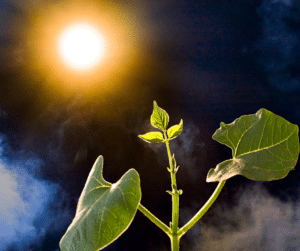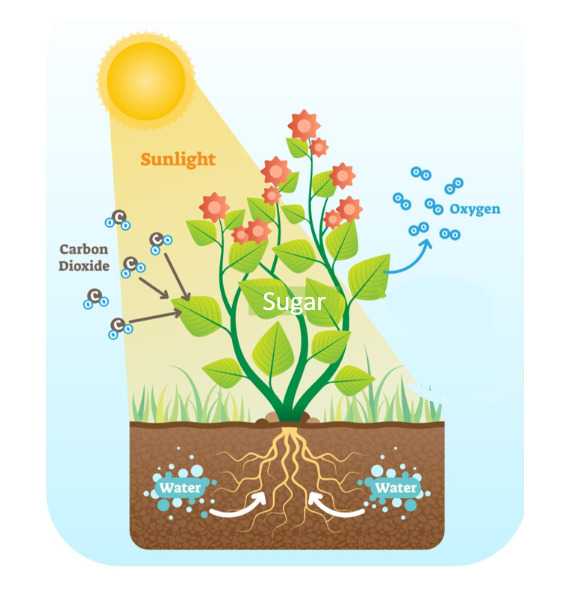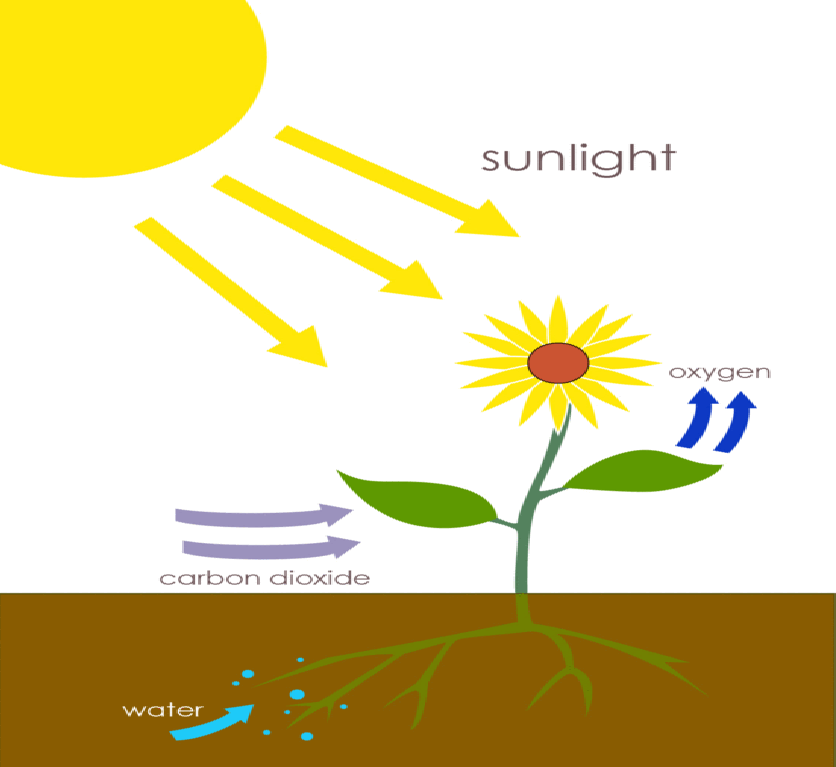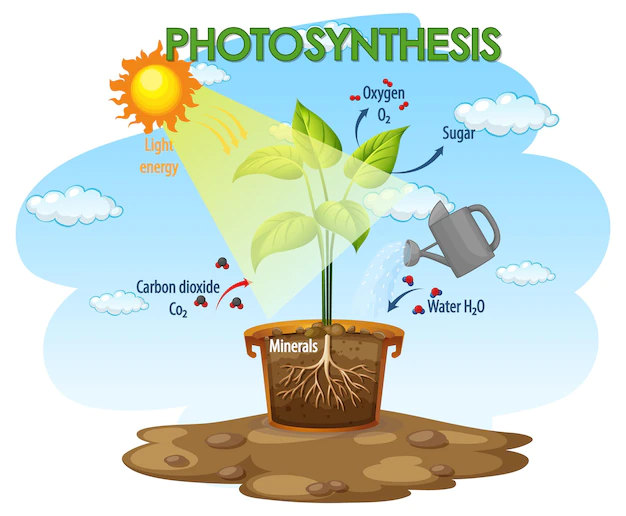The Marvel of Photosynthesis: Powering Life on Earth

Photosynthesis, the process by which plants, algae, and some bacteria convert light energy into chemical energy in the form of sugars, is arguably the most fundamental biological process on Earth. It is the cornerstone of nearly all food webs, providing the energy and oxygen that sustain the vast majority of life. Understanding photosynthesis is crucial not only for appreciating the intricate workings of the natural world but also for addressing pressing global challenges related to food security, climate change, and renewable energy.
The Basic Equation and Its Significance:
At its core, photosynthesis can be summarized by the following simplified equation:
6CO₂ + 6H₂O + Light Energy → C₆H₁₂O₆ + 6O₂
This equation tells a powerful story. Six molecules of carbon dioxide (CO₂) from the atmosphere combine with six molecules of water (H₂O) in the presence of light energy to produce one molecule of glucose (C₆H₁₂O₆), a simple sugar, and six molecules of oxygen (O₂).
This seemingly simple equation hides a complex series of biochemical reactions. Let’s break down the significance of each component:
- Carbon Dioxide (CO₂): Plants obtain CO₂ from the atmosphere through tiny pores on their leaves called stomata. CO₂ is the primary building block for the sugar molecules produced during photosynthesis.
- Water (H₂O): Water is absorbed from the soil through the roots of plants. It plays a crucial role in the electron transport chain, a vital part of the light-dependent reactions.
- Light Energy: Sunlight provides the energy needed to drive the entire process. This energy is captured by pigments, primarily chlorophyll, within the plant’s cells.
- Glucose (C₆H₁₂O₆): This is the sugar molecule produced as a result of photosynthesis. It serves as the plant’s primary source of energy for growth, development, and reproduction. Glucose can also be converted into other more complex carbohydrates like starch for storage.
- Oxygen (O₂): Oxygen is a byproduct of photosynthesis. It is released into the atmosphere and is essential for the respiration of most living organisms, including plants themselves.

The Two Main Stages of Photosynthesis:
Photosynthesis is a two-stage process, each with its own set of complex reactions:

1. Light-Dependent Reactions (The "Light" Reactions):
These reactions occur in the thylakoid membranes within the chloroplasts, the organelles where photosynthesis takes place. The primary goal of the light-dependent reactions is to convert light energy into chemical energy in the form of ATP (adenosine triphosphate) and NADPH (nicotinamide adenine dinucleotide phosphate).
- Light Absorption: Chlorophyll and other accessory pigments absorb light energy. Chlorophyll a and chlorophyll b are the main pigments, absorbing light in the blue-violet and red regions of the spectrum. Accessory pigments, such as carotenoids, absorb light in other regions and transfer the energy to chlorophyll.
- Photosystems: The absorbed light energy is funneled to two main protein complexes called Photosystem II (PSII) and Photosystem I (PSI). Each photosystem contains a reaction center chlorophyll molecule that becomes energized by the light.
- Electron Transport Chain: PSII uses light energy to split water molecules (photolysis) into electrons, protons (H+), and oxygen. The electrons are then passed along an electron transport chain, a series of protein complexes embedded in the thylakoid membrane. As electrons move down the chain, they release energy, which is used to pump protons from the stroma (the space surrounding the thylakoids) into the thylakoid lumen, creating a proton gradient.
- ATP Synthesis: The proton gradient created by the electron transport chain drives the synthesis of ATP through a process called chemiosmosis. Protons flow down their concentration gradient through an enzyme called ATP synthase, which uses the energy to convert ADP (adenosine diphosphate) into ATP.
- NADPH Formation: Electrons that reach the end of the electron transport chain from PSII are transferred to PSI. PSI absorbs more light energy and uses it to re-energize the electrons. These energized electrons are then used to reduce NADP+ (nicotinamide adenine dinucleotide phosphate) to NADPH.

In summary, the light-dependent reactions use light energy to split water, generate ATP, and produce NADPH. Oxygen is released as a byproduct.
2. Light-Independent Reactions (The "Dark" Reactions or Calvin Cycle):
These reactions occur in the stroma of the chloroplasts. The ATP and NADPH produced during the light-dependent reactions provide the energy and reducing power needed to convert CO₂ into glucose. The Calvin cycle is a cyclical series of reactions that can be divided into three main phases:
- Carbon Fixation: CO₂ from the atmosphere is combined with a five-carbon molecule called ribulose-1,5-bisphosphate (RuBP), catalyzed by the enzyme RuBisCO (ribulose-1,5-bisphosphate carboxylase/oxygenase). This reaction forms an unstable six-carbon molecule that immediately breaks down into two molecules of 3-phosphoglycerate (3-PGA).
- Reduction: ATP and NADPH are used to convert 3-PGA into glyceraldehyde-3-phosphate (G3P), a three-carbon sugar. Some G3P molecules are used to synthesize glucose and other organic molecules, while others are used to regenerate RuBP.
- Regeneration of RuBP: The remaining G3P molecules are used in a complex series of reactions to regenerate RuBP, ensuring that the Calvin cycle can continue. This process requires ATP.
In summary, the Calvin cycle uses the ATP and NADPH generated during the light-dependent reactions to fix CO₂ and produce glucose.
Factors Affecting Photosynthesis:
Several factors can influence the rate of photosynthesis:
- Light Intensity: As light intensity increases, the rate of photosynthesis generally increases until it reaches a saturation point. Beyond this point, further increases in light intensity do not lead to a significant increase in the rate of photosynthesis and can even damage the photosynthetic apparatus.
- Carbon Dioxide Concentration: The rate of photosynthesis increases with increasing CO₂ concentration, up to a certain point. However, extremely high CO₂ concentrations can be toxic to plants.
- Temperature: Photosynthesis is an enzymatic process, and its rate is affected by temperature. Generally, the rate of photosynthesis increases with increasing temperature up to an optimal temperature. Beyond this optimal temperature, the rate of photosynthesis decreases due to enzyme denaturation.
- Water Availability: Water is essential for photosynthesis. Water stress can lead to stomatal closure, which reduces CO₂ uptake and inhibits photosynthesis.
- Nutrient Availability: Nutrients such as nitrogen, phosphorus, and potassium are essential for the synthesis of chlorophyll and other photosynthetic components. Nutrient deficiencies can limit photosynthesis.
Adaptations for Photosynthesis in Different Environments:
Plants have evolved various adaptations to optimize photosynthesis in different environments:
- C4 Photosynthesis: C4 plants, such as corn and sugarcane, have evolved a mechanism to concentrate CO₂ in specialized cells called bundle sheath cells. This allows them to perform photosynthesis efficiently even in hot, dry environments where stomata must be closed to conserve water.
- CAM Photosynthesis: CAM (Crassulacean acid metabolism) plants, such as cacti and succulents, open their stomata at night to take up CO₂ and store it as an organic acid. During the day, when stomata are closed to prevent water loss, the stored CO₂ is released and used in the Calvin cycle.
The Importance of Photosynthesis:
Photosynthesis is essential for life on Earth for several reasons:
- Primary Energy Source: Photosynthesis is the primary source of energy for nearly all ecosystems. Plants, algae, and photosynthetic bacteria convert light energy into chemical energy, which is then passed on to other organisms through food webs.
- Oxygen Production: Photosynthesis is the source of nearly all the oxygen in the Earth’s atmosphere. Oxygen is essential for the respiration of most living organisms.
- Carbon Dioxide Removal: Photosynthesis removes CO₂ from the atmosphere, helping to regulate the Earth’s climate. Plants act as carbon sinks, storing carbon in their biomass.
- Food Production: Photosynthesis is the basis of all food production. Crops are grown to provide food for humans and livestock.
Photosynthesis and Climate Change:
Photosynthesis plays a crucial role in mitigating climate change by removing CO₂ from the atmosphere. However, deforestation and other human activities are reducing the amount of photosynthetic biomass on Earth, which is contributing to the increase in atmospheric CO₂ levels. Understanding and enhancing photosynthesis is therefore crucial for addressing climate change. This can involve efforts to protect and restore forests, improve agricultural practices, and develop new technologies to capture and utilize CO₂.
Conclusion:
Photosynthesis is a remarkable and complex process that underpins nearly all life on Earth. Its intricate mechanisms, adaptations to diverse environments, and vital role in regulating the Earth’s atmosphere make it a subject of ongoing scientific investigation. By understanding photosynthesis, we can better appreciate the interconnectedness of life and develop strategies to address global challenges related to food security, climate change, and sustainable energy. Further research into optimizing photosynthetic efficiency in crops and developing artificial photosynthesis technologies holds the promise of a more sustainable future.
Frequently Asked Questions (FAQ) about Photosynthesis:
Q: What is the difference between the light-dependent and light-independent reactions?
A: The light-dependent reactions use light energy to split water, generate ATP, and produce NADPH. The light-independent reactions (Calvin cycle) use the ATP and NADPH generated during the light-dependent reactions to fix CO₂ and produce glucose.
Q: What is chlorophyll?
A: Chlorophyll is the primary pigment in plants that absorbs light energy for photosynthesis. There are different types of chlorophyll, such as chlorophyll a and chlorophyll b, which absorb light at different wavelengths.
Q: What is RuBisCO?
A: RuBisCO (ribulose-1,5-bisphosphate carboxylase/oxygenase) is the enzyme that catalyzes the first step of the Calvin cycle, the fixation of CO₂. It is the most abundant enzyme on Earth.
Q: What are C4 and CAM photosynthesis?
A: C4 and CAM photosynthesis are adaptations that allow plants to perform photosynthesis efficiently in hot, dry environments. C4 plants concentrate CO₂ in bundle sheath cells, while CAM plants open their stomata at night to take up CO₂.
Q: What factors affect the rate of photosynthesis?
A: Light intensity, carbon dioxide concentration, temperature, water availability, and nutrient availability can all affect the rate of photosynthesis.
Q: Why is photosynthesis important?
A: Photosynthesis is essential for life on Earth because it is the primary source of energy for nearly all ecosystems, it produces oxygen, it removes carbon dioxide from the atmosphere, and it is the basis of all food production.
Q: How can we improve photosynthesis to address climate change?
A: We can improve photosynthesis by protecting and restoring forests, improving agricultural practices, and developing new technologies to capture and utilize CO₂. Research into optimizing photosynthetic efficiency in crops and developing artificial photosynthesis technologies is also promising.
Q: What is artificial photosynthesis?
A: Artificial photosynthesis is the development of synthetic systems that mimic natural photosynthesis to convert sunlight, water, and carbon dioxide into fuels or other valuable chemicals.
Q: Where does photosynthesis occur?
A: Photosynthesis occurs in chloroplasts, which are organelles found in plant cells and algae.
Q: What is the role of water in photosynthesis?
A: Water provides the electrons needed for the electron transport chain in the light-dependent reactions. The splitting of water molecules also releases oxygen as a byproduct.
